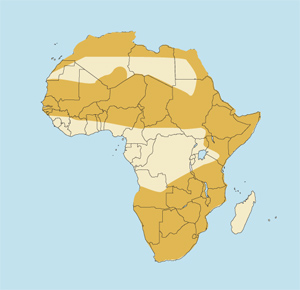 |
Caracal caracal
Caracal (Sp), Karacal, Wüstenluchs (G), Caracal (F), Rooikat (Af). "Caracal" is derived from the Turkish karahkulak, or black ear. Sometimes called "caracal lynx," which is incorrect because it is not a lynx and is actually very different from the lynxes.
DESCRIPTION Head and body length 24-36 inches (61-91 cm), average 30 inches (76 cm). Tail 9-12 inches (23-30 cm). Shoulder height 15-20 inches (38-51 cm). Weight (male) 32-42 lbs (15-19 kg). Females weigh 8-10 percent less. Unlike most cats, caracals usually have 28 teeth (i3/3, c1/1, pm2/2, m1/1), but some individuals exhibit pm3/2 for a total of 30. The female normally has two pairs of teats.
The caracal is the largest of the small African cats. It has a long, slender, uniformly colored body with a comparatively short, tapering tail and long, tufted ears. The short, thick coat varies from grayish to reddish-brown, with white on chin, throat and underparts, and a black line from eye to nose. Coloration tends to be lighter in arid regions and darker where there is more rain. Black (melanistic) individuals are occasionally seen. The hind legs are longer than the forelegs, so that the animal appears to be tilted forward. The caracal's ears are its most distinctive feature, being long, narrow and pointed, black on the outside, and topped with 1-3/4 inch (45 mm) tufts of black hair.
BEHAVIOR Solitary and reportedly territorial. Breeding probably occurs year-round, with 1-4 young born after about 79 days gestation. Cubs stay with the mother for about a year. Females are sexually mature at 14-16 months and are believed to have one litter a year. Longevity in the wild unknown, in captivity as much as 19 years.
Largely nocturnal, but also is seen during daytime. Feeds mainly on birds, hares, rodents, hyraxes, monkeys and small antelopes. Able to take prey as large as impala, springbok and young greater kudu. Kills domestic livestock in some areas. Feeds on carrion at times. The caracal is a fast runner-the swiftest of the smaller African cats-a good tree climber and an exceptional jumper, leaping high in the air to knock down birds. Able to go without water for days by obtaining moisture from its prey. The caracal is easily tamed, and has been trained to hunt for its human owners in Iran and India.
HABITAT Mainly dry savanna, scrub and woodland. Not found in true desert or rain forest. Found as high as 8,000-10,000 feet (2,500-3,000 m) in the mountains of Ethiopia.
DISTRIBUTION Most of Africa except for the central Sahara and the tropical rain forests of West Africa, the Congo Basin, and Natal.
Outside of Africa, the caracal is found in southwestern Asia from the Middle East to northwestern India.
TAXONOMIC NOTES Seven subspecies are listed in Africa, plus another two in Asia. We do not separate them.
STATUS Plentiful in its African range. The Asian population, however, is listed on Appendix I of CITES.
|





